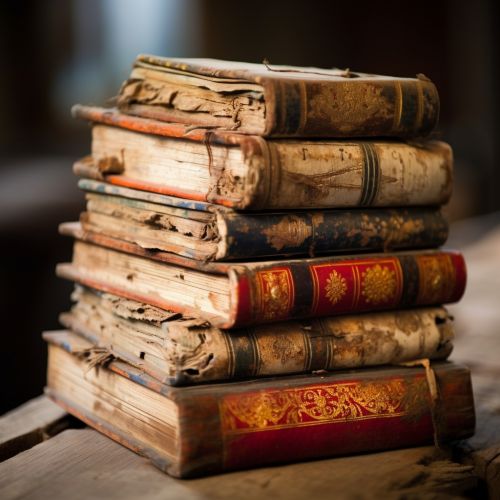Puranas
Origins and Development
The Puranas are a genre of important Hindu, Jain and Buddhist religious texts, notably consisting of narratives of the history of the universe from creation to destruction, genealogies of kings, heroes, sages, and demigods, and descriptions of Hindu cosmology, philosophy, and geography. The word Purana ('ancient', 'old') is derived from the root Purā (पुरा) which means 'former' or 'old' and in Vedic literature, it implies 'old, ancient or primeval'.


The Puranas are part of the Vedic literature corpus, the literary record of ancient Indian culture and beliefs, alongside other such scriptures as the Upanishads, Brahmanas, and Aranyakas. They are traditionally said to narrate five subjects, known as 'Pancha Lakshana' (पञ्चलक्षण): Sarga (creation), Pratisarga (recreation), Vamśa (genealogy of gods and sages), Manvañtara (cosmic cycles), and Vamśānucaritam (histories of the patriarchs).
Classification
The Puranas are classified into Mahāpurāṇas and Upapurāṇas. The Mahāpurāṇas are the most important and contain five distinguishing marks. They are said to be eighteen in number, divided into three groups of six, though they are not always counted in the same way. The Upapurāṇas are eighteen in number, with disagreement as to which canonical texts belong in that list of eighteen.
Content and Structure
The content of the Puranas, as well as their specific characteristics, are remarkably diverse. Each Purana typically features tales of gods and goddesses, legends about saints and heroes, instructions on rituals for rites of passage and life-cycle ceremonies, pilgrimages, festivals, charity, duties, rights, alms, social issues, and virtues and vice, among other topics. The structure of these texts is also complex, with each Purana divided into several sections, each of which deals with a specific topic or theme.
Influence and Significance
The Puranas have had a profound influence on Indian culture, shaping its mythology, customs, and ethical ideals. They have been a significant source of socio-religious, cultural and philosophical knowledge, shaping and guiding the moral and spiritual ethos of Indian civilization. The Puranas also provide a historical record of the rise and fall of dynasties, the evolution of religions and philosophies, and the development of arts and sciences in ancient India.
Criticism and Controversies
The Puranas have been subject to criticism and controversy. Some scholars have questioned their authenticity, accuracy, and reliability as historical documents, while others have criticized their perceived sectarian bias and their role in perpetuating social inequalities and prejudices. Despite these criticisms, the Puranas continue to be revered and studied for their religious, philosophical, and cultural insights.
